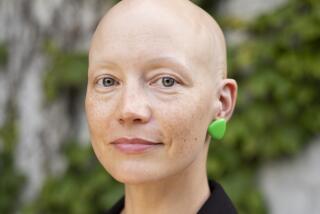BOOK REVIEW: FICTION : Magical Possibilities of Childhood : HULA <i> by Lisa Shea</i> ; W.W. Norton, $15, 155 pages
- Share via
Myths are the salt of human consciousness. It is hard to find a place for it, though, in our realistic fiction of personal sensibility which, despite the experimenters, the meta-fictionalists, the William Gaddises and Thomas Pynchons, goes on being written.
A credible American adult is not properly seen practicing myth unless, as with the Washington press corps, it is the myth of de-mythification. So writers turn to childhood, where even the most prosaic matters, being unfulfilled, still display magical possibility. A cheeseburger comes with a nimbus as well as ketchup.
“Hula” tells a grim, tawdry family story radiantly, by telling it through the eyes of two pre-adolescent sisters who, I imagine, are 11 and 12 in the first part and 12 and 13 in the second.
Set in an unnamed Southern town in the 1960s, it is narrated by the younger girl. In 12 brief chapters, each recording one tiny scene, she gives us glimpses of the breakdown of her father, a veteran with a head injury, and the breakup of their home.
The father, who has been in and out of mental hospitals, works desultorily on a vegetable garden behind the house. His passion is less for growing than for weeding and, above all, burning the weeds in an iron basket.
There is a violence that he tries to contain but that breaks out in ways that border on disaster. He keeps a gorilla mask and gloves, remnants of some forgotten costume party. At dinner one night he leaves the table, returns wearing the mask and hops around snatching bits of food from his family’s plates.
When he removes the gorilla head, the child tells us, there are tears in his eyes. There are regular shouting arguments between the father and the mother, a dance teacher who stays home for a while to try to hold things together but eventually returns to work. The children are sent outside and take refuge in a wrecked car on the lawn. From the house come angry voices and a regular thumping sound. It is the father beating his head against the wall.
There had been good times. The girls find a grass skirt the mother used to wear; she had met her husband, with his brilliant blue eyes and his intensity, while demonstrating the hula. The older sister puts the skirt on; the father snatches it off and burns it.
Later, drunk, he shoots holes in the garage with his pistol and ends up shooting to bits a pumpkin the children had grown. The narrator maneuvers herself across the lawn close to him until she is stepping on the shadow of his head.
It is a child’s protest; the sisters rebel in various other childish ways. But it is also a child exploring a mystery. Inside the tormented head on whose shadow she stands is the whole unraveling fate of their family.
In some ways, “Hula” resembles Susan Minot’s “Monkeys,” which also depicted a family’s disintegration in a series of vignettes told over time and as seen by the children. Like Minot, Lisa Shea makes touching, skillful use of the counterpoint between what a child can see and relate, and what she cannot. Her fabric is a lace of threads and holes that we fall through.
“Hula” is a smaller work; its sadness is less complex and its range more restricted. Some of the chapters, dealing with the older sister’s incipient sexuality, her fascination with a chain gang of convicts working near the house, and her roughhousing flirtation with neighbor boys, are nicely told but unremarkable.
But “Hula” achieves an aching intensity in its own right. The narrator lets us hear sorrowful things that she can only partly tell.
Shea has built, on a structure of voice and silence, the sorrowful image of a child’s vulnerability to the storms and mischances of her parents’ lives. The incidents are commonplace. What is magical is the image of two children packing and repacking their world, ready for instant evacuation.
More to Read
Sign up for our Book Club newsletter
Get the latest news, events and more from the Los Angeles Times Book Club, and help us get L.A. reading and talking.
You may occasionally receive promotional content from the Los Angeles Times.









